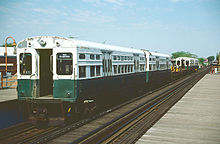steveintoronto
Superstar
Yeah, I see same for both engineering and cost challenges. That 'people mover' could be an orbital LRT loop that uses the present UPX elevated RoW and allows through running current bi-mode EMUs or LRVs onto the then electrified Georgetown line.This is even more true as the airport expands. The people mover (likely a modified one that can operate more than 2 trains) would collect and distribute passengers to the 4 to 6 airport related stops from the mainline station.
Example here:
https://en.wikipedia.org/wiki/British_Rail_Class_399[...]The primary purpose of the Class 399 units is to operate the tram-train service between Sheffield and Rotherham. As a consequence, they will be dual voltage vehicles capable of operating on both the 750 V OHLE of Supertram's network, and the 25 kV OHLE that is the standard on the National Rail network. Although the route to Rotherham will be electrified to the 750 V standard used on the rest of the Supertram network, the installation of dual voltage capability is to allow the vehicles to be "future-proofed" for use as and when the Midland Main Line north of Sheffield is electrified.[8] Additionally, because they will be operating on a heavy rail line, they will be subject to higher crashworthiness standards than the rest of Supertram's fleet, meaning that these units will be the only ones capable of operating the tram-train service to Rotherham.[5][9] However, they will also be used to strengthen Supertram's existing fleet, which has not been expanded since it was originally commissioned in 1992. The vehicles will be fully integrated into Supertram's fleet, and will be maintained by the manufacturer at the main Nunnery depot.[10] The Rotherham service is envisaged to operate every 20 minutes between Cathedral and Rotherham Central, before terminating at a new stop at Rotherham's Parkgate retail park, with a total journey time of approximately 25 minutes.[6] A total of three vehicles will be required for this service level; three of the remainder will be used to increase capacity on the rest of the network, with the seventh in maintenance.[8] Initially however, four of the seven vehicles will be dedicated to the Rotherham service, with the other three used for fleet expansion. This is owing to the different wheel profile required for running on National Rail tracks as opposed to Supertram's own. This is envisaged to be the case until Supertram has completed its full track replacement programme.[11]
The Alstom Citadis are one of many from the LRV family that are also used this way, so Union Express and LRTs would share the same loop encircling Pearson. (Think the Chicago L Loop, where the trains are technically LRVs anyway) Positive Train Control (PTC) would be used of course. The present flyways the UPX use could either be a stub spur off of the 'loop', or part of the loop itself if extended.
Last edited:


